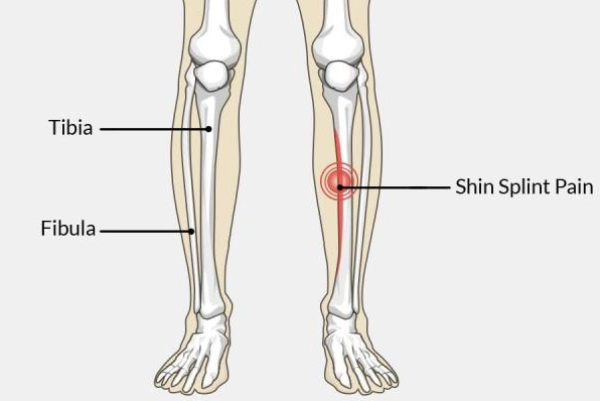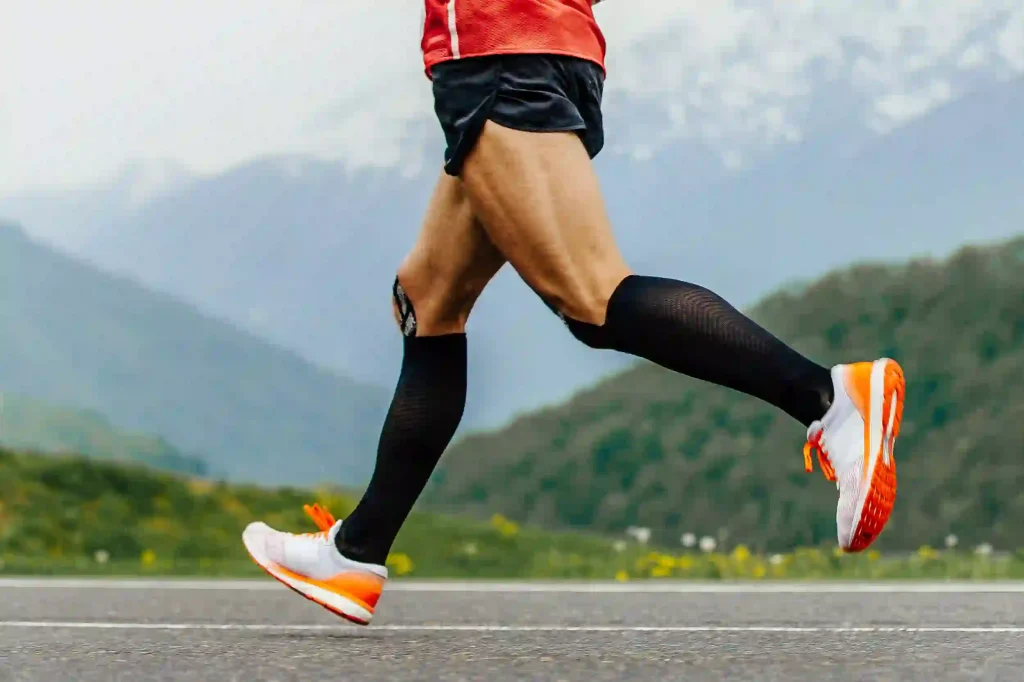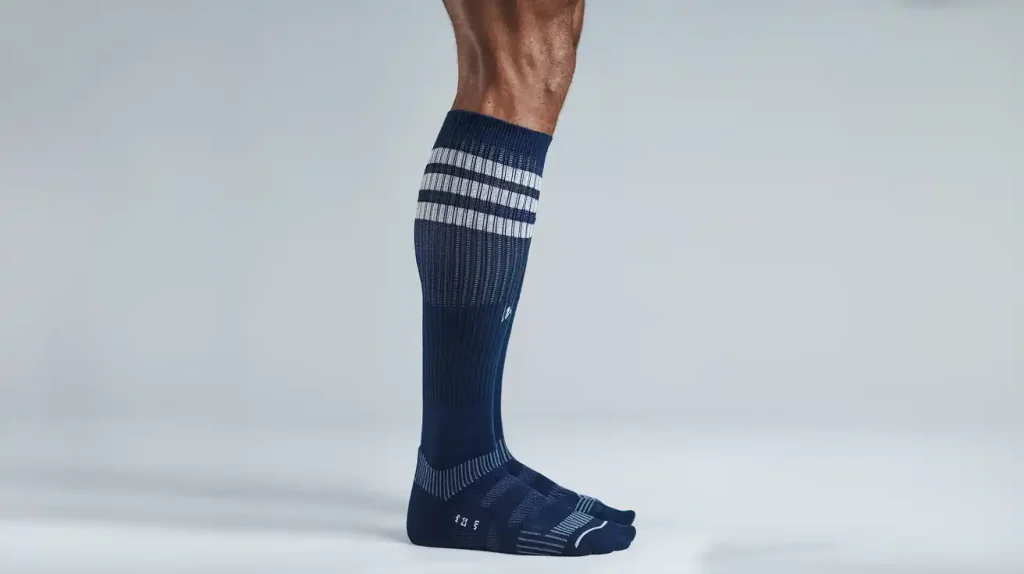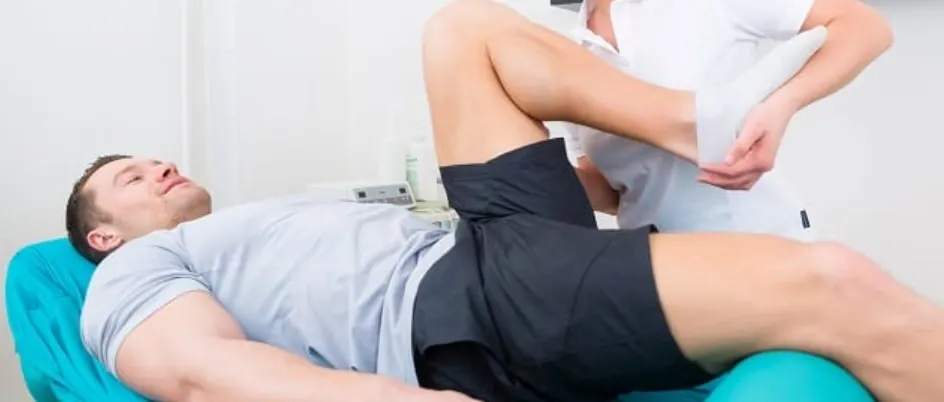Shin splints, a common condition that causes pain along the shinbone, are experienced by athletes, especially runners, and those who engage in high-impact sports. Compression socks are often recommended as a solution to reduce pain and promote recovery. But do compression socks for shin splints really help? Let’s explore the science behind it.
What Are Shin Splints?

Shin splints refer to pain in the lower leg, usually caused by inflammation in the muscles or tendons surrounding the shinbone. This condition is common in runners, dancers, and individuals who suddenly increase their physical activity level. The pain can be sharp or dull and is typically felt along the inner edge of the tibia, also known as the shinbone.
How Compression Socks Target Shin Splint Pain (The Science Behind the Relief)

Compression socks are not a cure, but they are a powerful adjunct treatment for Medial Tibial Stress Syndrome (MTSS). Their effectiveness is based on three core physiological principles:
Enhanced Blood Flow and Waste Removal
The graduated pressure (highest at the ankle, decreasing up the leg) actively encourages more efficient blood return to the heart. This boost in circulation achieves two critical things:
- Faster Nutrient Delivery: It rapidly delivers oxygen and essential nutrients to the inflamed muscle tissue surrounding the tibia (shin bone).
- Lactic Acid Flush: It accelerates the removal of metabolic waste products, like lactic acid, which contribute heavily to post-exercise soreness and fatigue.
Reducing Muscle Oscillation and Vibration
During high-impact activities like running or jumping, muscles vibrate excessively. This repetitive “jiggling” contributes to microtrauma, fatigue, and the inflammation that causes shin splints.
- Compression socks act like a stabilizing second skin, minimizing these muscle oscillations. By reducing excessive movement, they lower the impact stress on the lower leg muscles, tendons, and the bone itself.
Inflammation and Swelling Control
Shin splints are fundamentally an inflammatory response. The controlled pressure applied by the sock helps manage fluid dynamics:
- It aids in the drainage of excess fluid from the interstitial spaces (lymphatic system) that builds up during inflammation. This reduction in swelling directly translates to a decrease in pain and discomfort.
When Should You Use Compression Socks?

Compression socks should be used during and after physical activity, especially if you are prone to shin splints. They can help prevent the onset of pain and speed up recovery after a workout. It’s also recommended to wear them during long periods of standing or walking, as they provide support and prevent discomfort.
How to Choose the Best Compression Socks for Shin Splints

Choosing the right pair is essential to maximize relief and prevent issues like numbness or skin irritation. Focus on these three critical features:
| Feature | Why It Matters for Shin Splints | Actionable Tip |
| Graduated Compression (15-20 mmHg) | This design is crucial—it applies the highest pressure at the ankle and gradually decreases up the leg to optimize blood return and fight swelling. | Look for 15-20 mmHg (Moderate Compression) for daily wear and post-run recovery. Consult a doctor for higher pressures. |
| Moisture-Wicking Fabric | Intense activity leads to sweat. Non-breathable fabric can cause chafing and irritation, worsening your pain. | Choose blends like Nylon/Spandex or Merino Wool to keep your skin dry and prevent blisters. |
| Proper Fit & Length | Socks that are too tight can restrict circulation; too loose and they offer no benefit. Knee-high is the best length. | Measure your calf circumference (not just your shoe size) and check the brand’s size chart before purchasing. |
Can Compression Socks Fully Cure Shin Splints?
While compression socks can help alleviate the symptoms of shin splints, they are not a cure-all. It is important to address the underlying causes of shin splints, such as improper footwear, overtraining, or poor running form. Other treatments, including rest, stretching, ice therapy, and physical therapy, may also be necessary for full recovery.
Potential Drawbacks & When to Consult a Doctor

While compression socks are generally safe, improper use can be counterproductive:
- Risk of Improper Fit: Too tight, and they can cause numbness or actually restrict blood flow. Always refer to a professional size chart.
- Skin Irritation: Prolonged wear in hot conditions without proper material can lead to chafing or rashes.
- Pre-Existing Conditions: Individuals with pre-existing vascular issues (like Peripheral Artery Disease or severe DVT) must consult a healthcare provider before using compression therapy.
🚨 When to Seek Professional Advice: If your shin pain is severe, constant, or does not improve after a few weeks of rest and self-care, stop exercising and see a sports medicine physician. Untreated MTSS can progress to a stress fracture, which requires immediate medical attention.
FAQs About Compression Socks for Shin Splints
How do compression socks alleviate shin splint pain?
Compression socks apply graduated pressure to the lower legs, enhancing blood circulation and reducing swelling. This improved blood flow delivers more oxygen and nutrients to the affected muscles, aiding in faster recovery and alleviating pain associated with shin splints.
Can compression socks prevent shin splints during exercise?
Yes, wearing compression socks during physical activities can provide support to the muscles and tendons, reducing the risk of developing shin splints. They help stabilize the lower legs, minimizing the strain that leads to overuse injuries.
What compression level is recommended for shin splints?
Moderate compression levels, typically between 15-20 mmHg, are generally recommended for managing shin splints. This range provides sufficient pressure to improve circulation without causing discomfort.
How long should compression socks be worn for shin splints relief?
For best results, wear compression socks during physical activity and for a few hours post-exercise. Consistent use can help reduce symptoms and promote faster recovery.
Are there any risks associated with wearing compression socks for shin splints?
Compression socks are generally safe for most individuals. However, those with certain conditions, such as peripheral artery disease, should consult a healthcare professional before use.
Are Compression Socks Right for You?

Compression socks can be a helpful addition to your treatment plan for shin splints. They can reduce pain, swelling, and improve circulation, aiding in a quicker recovery. However, they should be used in conjunction with other treatments and preventive measures for the best results.
If you suffer from frequent shin splints, consult a healthcare professional to develop a comprehensive treatment strategy that works for you.
Looking to bulk order or customize compression socks for your business needs?
Feel free to reach out to us for a personalized quote or to discuss your custom requirements. You can easily submit your inquiry through the form located on the right or below the screen.
